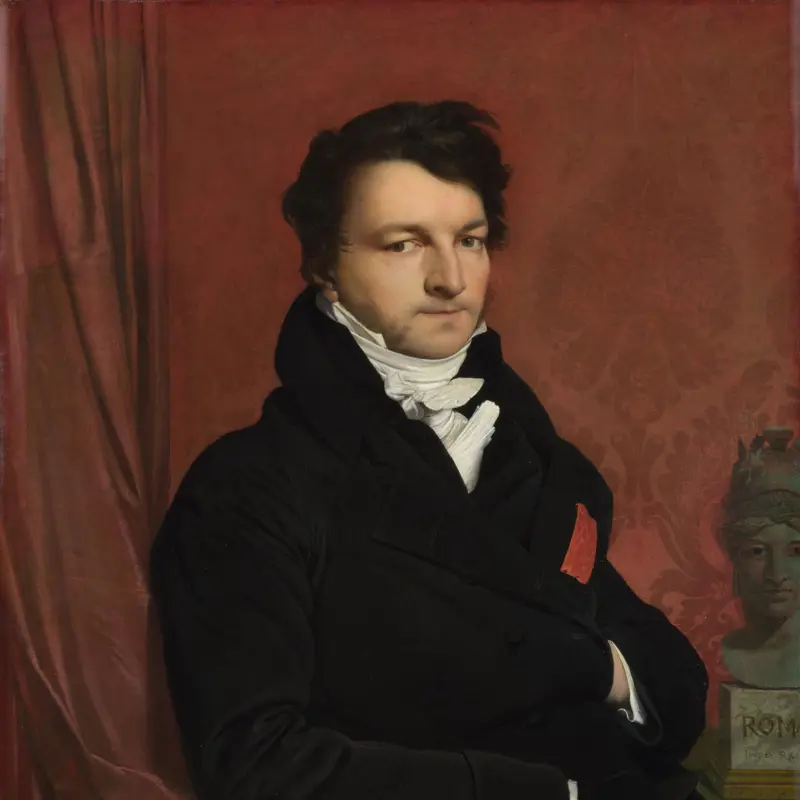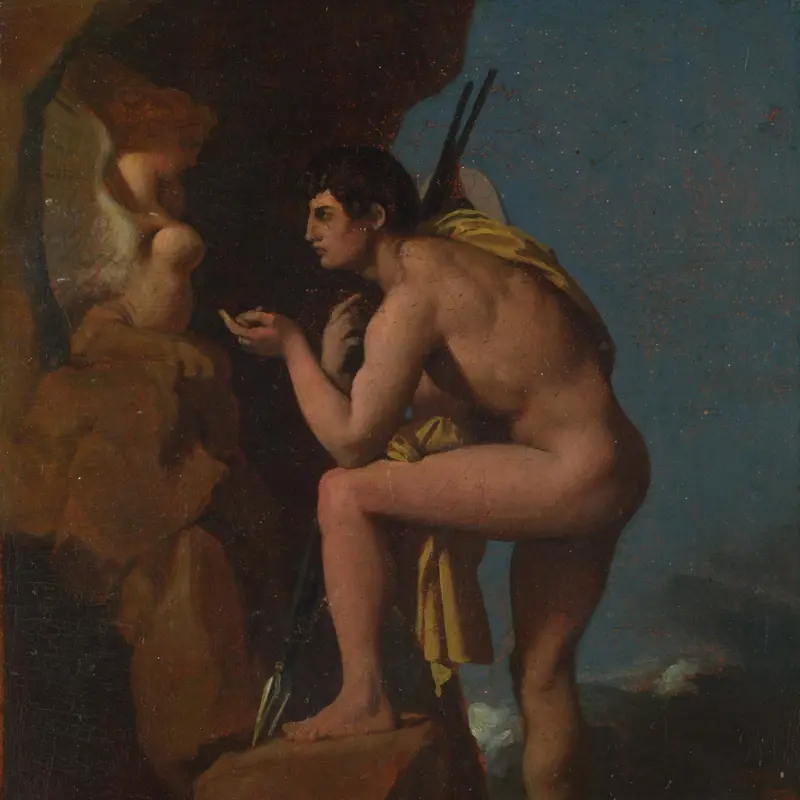Jean-Auguste-Dominique Ingres, 'Angelica saved by Ruggiero', 1819-39
About the work
Overview
The scene shown here is taken from an episode in the sixteenth-century epic poem Orlando Furioso, by Ludovico Ariosto. The Christian knight Ruggiero has discovered the pagan princess Angelica, who has been abducted by barbarians. Stripped and chained to a rock, she has been left as a sacrifice to a sea monster. Riding a hippogriff – a legendary half-horse, half-griffin beast that can both gallop and fly – Ruggiero saves Angelica by plunging his lance into the monster’s open jaws.
Ingres had previously painted a larger version of this story in 1819 for the Throne Room at the Palace of Versailles. In this smaller version, he emphasises the drama by reducing the seascape setting and placing the monster between Ruggiero and Angelica. He highlights the danger Angelica faces by contrasting her smooth, pale body with the hard armour and rocks and the sharp lance, griffin’s beak and talons, and the monster’s teeth.
Key facts
Details
- Full title
- Angelica saved by Ruggiero
- Artist dates
- 1780 - 1867
- Date made
- 1819-39
- Medium and support
- oil on canvas
- Dimensions
- 47.6 × 39.4 cm
- Inscription summary
- Signed
- Acquisition credit
- Bought, 1918
- Inventory number
- NG3292
- Location
- Room 38
- Collection
- Main Collection
- Previous owners
- Frame
- 19th-century French Frame
Provenance
Additional information
Text extracted from the ‘Provenance’ section of the catalogue entry in Martin Davies, with additions and some revisions by Cecil Gould, ‘National Gallery Catalogues: French School: Early 19th Century, Impressionists, Post-Impressionists, etc.’, London 1970; for further information, see the full catalogue entry.
Exhibition history
-
2011Degas and the NudeMuseum of Fine Arts, Boston9 October 2011 - 5 February 2012Musée d'Orsay12 March 2012 - 1 July 2012
-
2012Seduced by Art: Photography Past and PresentThe National Gallery (London)31 October 2012 - 20 January 2013CaixaForum Barcelona21 February 2013 - 19 May 2013CaixaForum Madrid19 June 2013 - 15 September 2013
-
2016Painters' Paintings: From Freud to Van DyckThe National Gallery (London)23 June 2016 - 4 September 2016
-
2020Masterpieces from the National Gallery, LondonThe National Museum of Western Art18 June 2020 - 18 October 2020The National Museum of Art3 November 2020 - 31 January 2021
-
2021Botticelli to Van Gogh: Masterpieces from the National Gallery, LondonNational Gallery of Australia5 March 2021 - 14 June 2021
Bibliography
-
1870H. Delaborde, Ingres: Sa Vie, ses travaux, sa doctrine, Paris 1870
-
1909A. Boyer d'Agen, Ingres d'après une correspondance inédite, Paris 1909
-
1911H. Lapauze, Ingres: Sa vie et son oeuvre (1780-1867), Paris 1911
-
1918Galerie Georges Petit, Catalogue des tableaux modernes et anciens, aquarelles, pastels, dessins, par Bartholomé … composant la collection de Edgar Degas, Paris, 26 March 1918 - 27 March 1918
-
1936C.J. Holmes, Self and Partners (mostly Self), London 1936
-
1946Martin Davies, National Gallery Catalogues: French School, London 1946
-
1954G. Wildenstein, The Paintings of J. A. D. Ingres, London 1954
-
1956N. Schlenoff, Ingres: Ses sources littéraires, Paris 1956
-
1957Martin Davies, National Gallery Catalogues: French School, 2nd edn (revised), London 1957
-
1967R. Rosenblum, Jean-Auguste-Dominique Ingres, New York 1967
-
1970Davies, Martin, and Cecil Gould, National Gallery Catalogues: French School: Early 19th Century, Impressionists, Post-Impressionists etc., London 1970
-
1983P. Condon et al., In Pursuit of Perfection: The Art of J.-A.-D.Ingres (exh. cat. Speed Art Museum, 6 December 1983 - 29 January 1984; Kimbell Art Museum, 3 March - 6 May 1984), Indiana 1983
-
1985A. Boime, 'Declassicizing the Academic: A Realist View of Ingres. Review of "Ingres: In Pursuit of Perfection"', Art History, VIIII, 1985, pp. 57-60
-
1989D. Sutton, 'The Degas Sales and England', The Burlington Magazine, CXXXI/1033, 1989, pp. 266-72
-
1995N. MacGregor, 'To the Happier Carpenter': Rembrandt's War-Heroine Margaretha de Geer, the London Public and the Right to Pictures, Gerson Lecture 8, Groningen 1995
-
1995G. Vigne, Ingres, Paris 1995
-
1996A. Dumas, Degas as a Collector, London 1996
-
1997A. Dumas et al., The Private Collection of Edgar Degas (exh. cat. Metropolitan Museum of Art, 1 October 1997 - 11 January 1998), New York 1997
-
2001
C. Baker and T. Henry, The National Gallery: Complete Illustrated Catalogue, London 2001
About this record
If you know more about this work or have spotted an error, please contact us. Please note that exhibition histories are listed from 2009 onwards. Bibliographies may not be complete; more comprehensive information is available in the National Gallery Library.






